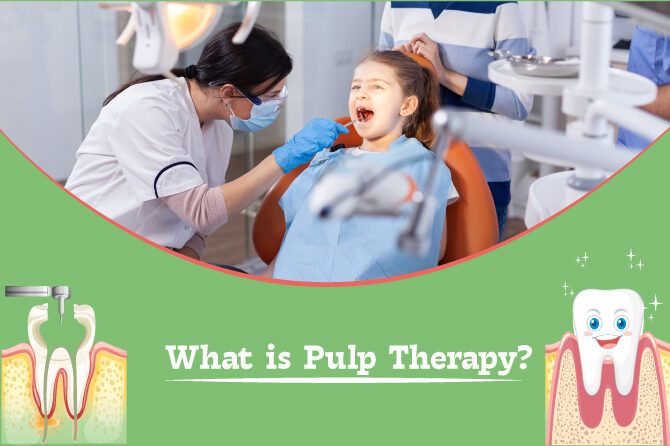
What Is Pulp Therapy?
The tissue, nerves, and blood vessels that fill a tooth’s internal cavity and root canals are called the pulp in your child’s teeth. The pulp’s job is to feed the tooth’s root with blood that is rich in nutrients and oxygen. Pulp exposure, discomfort, and inflammation can result from teeth that have been damaged by caries, trauma, or other factors. When this happens, the major goal of Pediatric pulp therapy is to keep the tooth and its supporting tissues healthy and intact. The pulp is essential to the appropriate growth of the apex of a tooth’s root, which is vital in young permanent teeth with immature roots.
What is Pulp?
Each tooth has a pulp chamber in the centre. It is made up of tissue, nerves, and blood vessels that function to keep the tooth healthy by supplying it with oxygen and nutrition.
Signs of Injured or Damaged Pulp
When pulp is exposed in teeth that have been harmed by trauma or teeth decay, it can result in excruciating pain and swelling in the affected area. Following are symptoms of infected or irritated pulp:
- persistent or mysterious pain
- Night-time pain
- sensitivity to the temperature of food
- around the diseased tooth in swelling
What is Pulp Therapy?
Using pulp therapy, the dentist can keep the tooth so it doesn’t fall out. It removes the unhealthy pulp from the tooth’s crown. The pulp root is still strong and unharmed. An substance is inserted into the tooth after the diseased area has been removed to stop bacterial growth, prevent infection, and relax the tooth’s nerve. The tooth is covered with a crowns. The crown reinforces the tooth and reduces the possibility of further fractures. Both baby and permanent teeth may be treated with pulpotomy.
When the entire pulp is affected, from the tooth’s crowns to its root canals, a pulpectomy is required. The tooth’s unhealthy pulp has been totally removed. The canals are then cleaned, sanitised, and filled with a substance that will eventually dissolve. The substance employed is non-resorbable if the tooth is a permanent tooth. To strengthen and support the tooth, a crown must be placed over it as the last stage.
Why Preserve A Damaged Baby Tooth?
Early tooth loss can influence a child’s ability to chew and speak, as well as the alignment of the permanent teeth that are occultly forming. Furthermore, a missing tooth could cause the teeth next to it to shift and tilt, which could lead to crooked teeth, a crowded mouth, or bite issues. Therefore, it is frequently preferable to attempt to salvage a newborn tooth with damaged pulp as opposed to just extracting the tooth.
How Can You Prevent Dental Pulp Damage?
The best method to avoid pulp damage is to ensure that your child’s teeth are strong and safe from harm. This entails strict oral hygiene routines, routine dental examinations and cleanings, and utilizing tailored mouthguards to protect your child’s teeth during sporting activities.
How it Works?
The pulp chamber and deterioration are removed during pulpotomy. Contrary to a typical root canal procedure, the dental nerves are not removed or otherwise dealt with in this area after sterilization. Sometimes only a portion of the tooth pulp is removed, preserving the life force of the healthy pulp that is still present. To keep the pulp healthy in these instances, we frequently employ a therapeutic dressing. The tooth frequently needs a dental crown once the decayed pulp has been removed and the tooth has been thoroughly cleaned. For children, we most frequently advise stainless steel crowns.
When Should Pulp Therapy be Recommended?
Every circumstance is different. Before recommending tooth extraction or pulp therapy to save the tooth, the pediatric dentist evaluates the child’s age, the position of the tooth, and their general health.
The following is a list of some negative effects of missing or prematurely pulled teeth:
- Arches can become shorter.
- The development of opposing teeth may be protruding or unfavourable.
- Premolars may experience excruciating impact.
- The rest of the teeth might “move” to close the gap.
- An aberrant tongue position is possible.
Lastly,
To find out more about pediatric pulp therapy’s role in helping to save your child’s teeth, get in touch with Kids Dental Studio. At the child-friendly clinic, Dr. Kisha Mehta and Dr. Umangi Lekhadia constantly work hard to provide every patients with great and considerate care in order to help them keep their healthy, joyful smiles!
Leave a reply